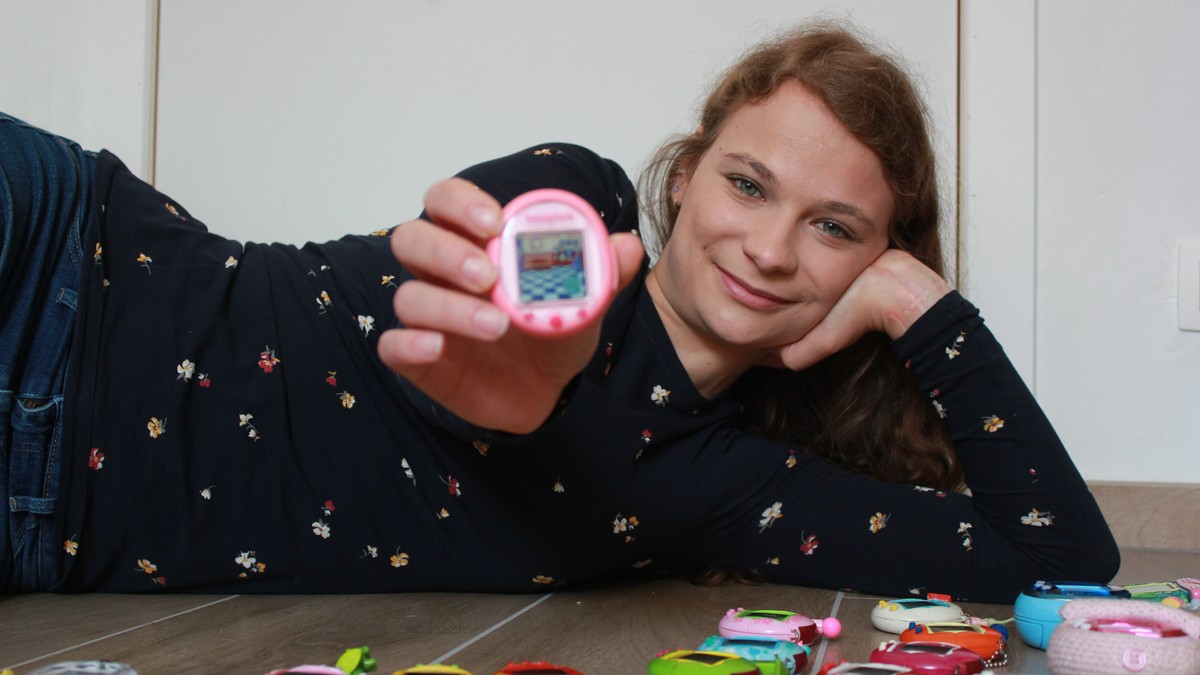Alicia Kostoglou, 24, lives in a quiet suburb of the Belgian city of Charleroi, with brick terraced houses as far as the eye can see. Kostoglou works as a sports teacher for children with disabilities, and also has a hobby that sometimes feels like a second job.
“Every morning I wake them up, see if they’re hungry, and clean up after they’ve pooped,” she says. “I give them a bath, then I clean their house or I play with them.” Kostoglou is not talking about her children or puppies, but about her Tamagotchi’s† She currently cares for four at a time – as we talk, she holds one in both hands, and also wears two on her wrists.
–
Tamagotchis were launched in 1996 by the Japanese toy manufacturer Bandai. Being digital pets that live in an ovoid device. In the early 2000s they conquered the world: every child wanted one. And because keeping Tamagotchi’s alive requires dedication and routine, every child has seen their Tamagotchi die at least a million times. If a Tamagotchi’s needs are ignored, they will simply die, often much to the horror of their owner.
–
Kostoglou, on the other hand, is a real pro: the critters she now cares for are actually the great-great-great-grandchildren of her original Tamagotchis. As a Tamagotchi breeder, she doesn’t just want to keep her creatures alive: when they grow up, she makes sure that they marry each other and then have children, so that they in turn can grow up and reproduce.
Kostoglou’s personal best to date is 65 consecutive generations. She shows us evidence of one of the bloodlines she started by putting batteries in an ‘ancestor device’.
“If I have all four on at the same time, it can take me half an hour to have breakfast,” she says. Even at work, usually during her lunch break, she often has to check them out. “I always have my Tamagotchis on the table next to me, I can look at them and tell a story at the same time,” she says. “My colleagues know it’s just part of me, it’s how I work.” Even during our conversation, she keeps looking, like someone checking their phone all the time.
–
Above, Kostoglou shows us her collection of Tamagotchi’s. There are 23 of them, all disabled – a group of pink, yellow and blue toys, some with decorative chains. Tens of generations of virtual pets are sleeping in each of these plastic eggs. When Kostoglou wants to expand her herd of Tamagotchis, she puts her old digital pets back on and starts up the bloodlines where she left off.
You may be wondering now, how the hell do you become a Tamagotchi breeder? For Kostoglou, it all started when she was seven years old. It was 2004we listened to ‘Yeah!’ van Usher to our iPods and Tamagotchis conquered primary and secondary schools around the world. Kostoglou’s mother was not too fond of this craze. She wanted her daughter to play outside rather than spend all the time behind a screen.
But Kostoglou was a smart child and found an ally in her grandmother, who gave her her first Tamagotchi for her birthday. Two weeks later, no less than 25 generations of Tamagotchis had been born in this little pink egg.
–
“I was so busy with that Tamagotchi that I blew up the memory card,” recalls Kostoglou. “No matter what I tried, the thing was beyond repair.” Fortunately, her grandmother came to her rescue and gave her a second chance. “This is the last you get!” her mother warned her. Spoiler: It wasn’t. This second Tamagotchi was the golden egg for Kostoglou: she realized she could breed the virtual creatures. That day her little empire was born.
–
Kostoglou has doubled her Tamagotchi breeding in the past three years. She has developed a whole system: she carefully prints out the different pedigrees of the Tamagotchis and sticks them in a notebook. She is fascinated by the endless possibilities the game offers. “I try to create unusual hybrids,” she says. “Sometimes I try to make a character exactly the same as his father or mother. But that is impossible.” She did collect a bunch of cheat codes, though, which allow her to get several coveted objects.
Kostoglou also shares her passion with a vibrant community of about three hundred players, collectors and breeders on a French facebook group† In addition, she follows a few Spanish and English Tamagotchi lovers op Instagramwith whom she regularly arranges playdates to keep her virtual children happy.
–
Kostoglou leaves her out Tamagotchi Pix to see. This updated version of the cult classic was launched in 2021. The Tamagotchi Pix has a few upgrades, including a built-in camera and touch buttons. It allows you to play in augmented reality, a bit like in Pokémon Go, though users have complained that the camera is of too low quality for these functions.
For example, you can take pictures of two ingredients and have the egg prepare a recipe for your pet, or point your camera at a garden and unlock new characters that way. So Kostoglou played outside anyway, as her mother always wanted. For her part, Kostoglou’s mother has accepted her daughter’s passion, although she still finds it difficult to understand.
Kostoglou lives with her boyfriend Jean-Michel Bertinchamps (31), and he has already had a lot of problems with all those plastic eggs around him. “It’s more than a passion, it’s an obsession,” he says. “She plays with them all day long, no matter what we do or wherever we go.” He has asked her to take a break “at least during meals and at night”, for the sake of their relationship. A few months ago, he was awakened at night by Tamagotchis demanding attention.
Kostoglou, on the other hand, is determined to make her boyfriend as excited about the game as she is, and she regularly hands her beloved virtual pets into his hands. Bertinchamps considers himself too old for this, in his opinion, childish game. He prefers to playFIFA on the PS4. “There’s less repetition in it,” he says. To each his own.
This article originally appeared on VICE France.
Follow VICE Belgium in VICE Netherlands also on Instagram.
–


:quality(80)/cdn-kiosk-api.telegraaf.nl/8d5155c0-e19a-11ec-b54e-0217670beecd.jpg)